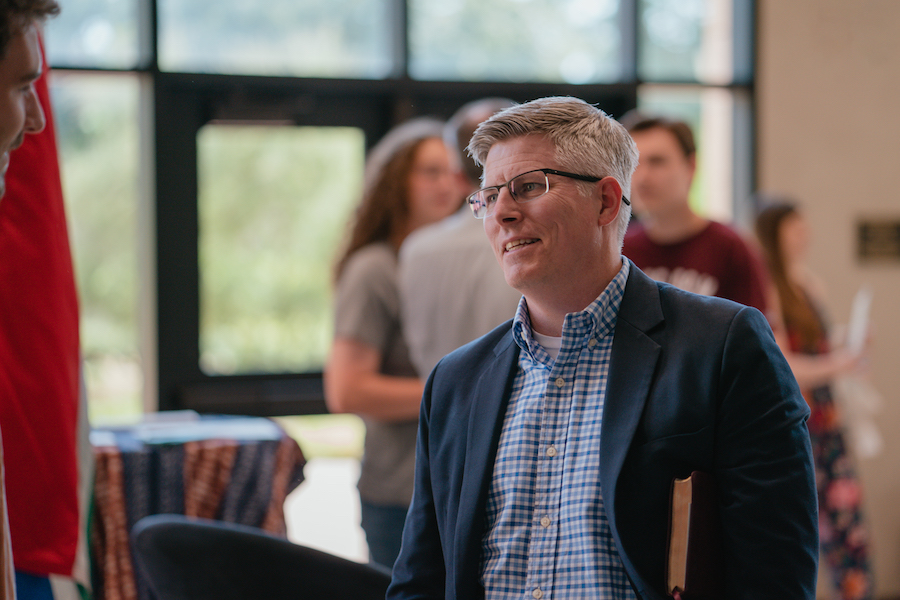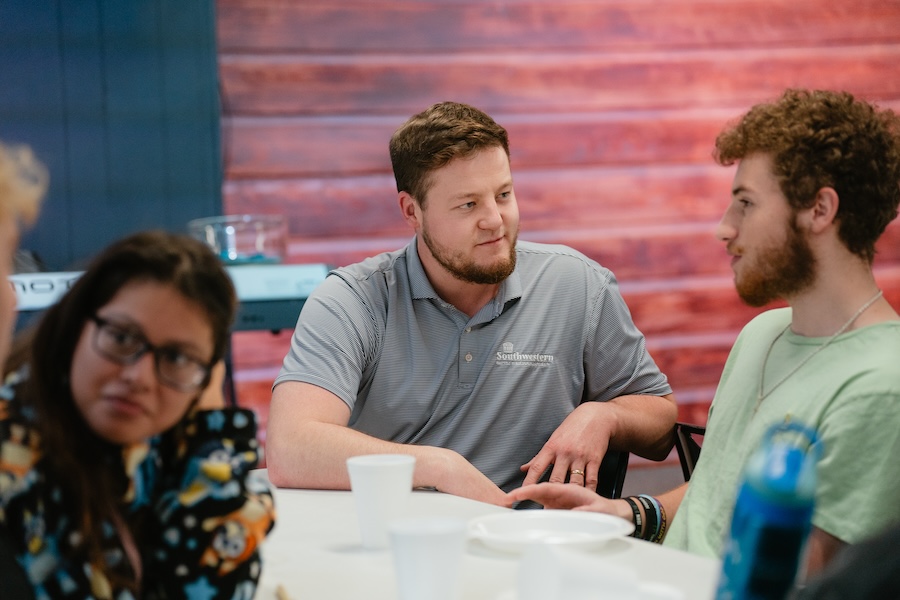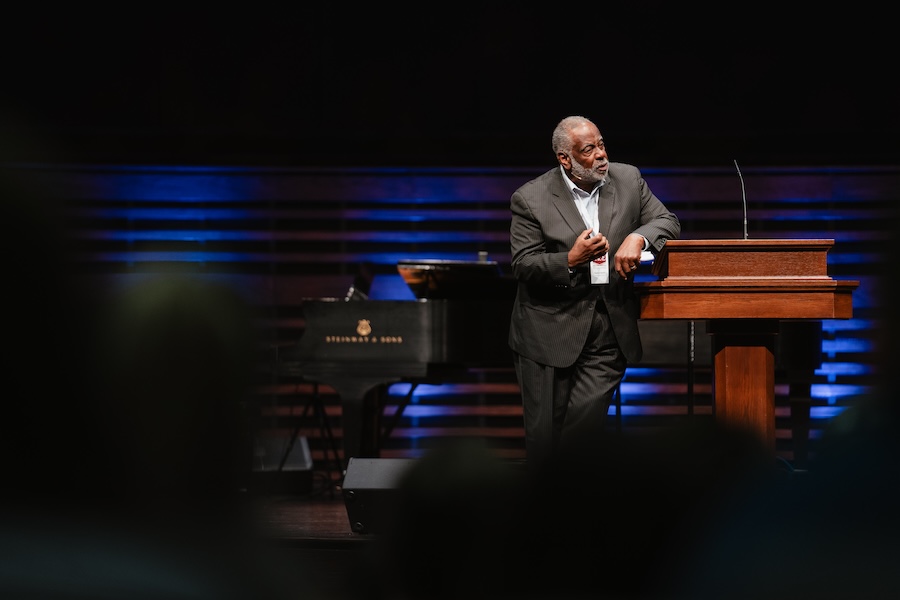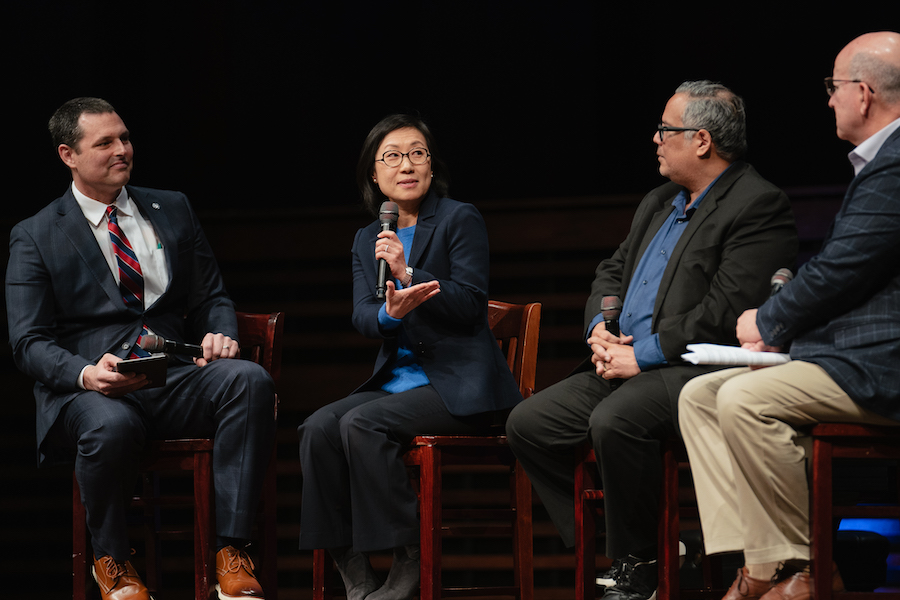SWBTS Legacy: L.R. Scarborough
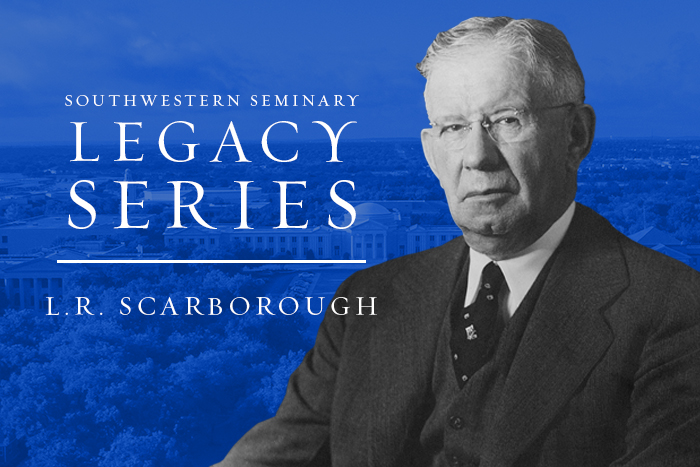
B.H. Carroll was dying. Though his students and colleagues would later affectionately call him “the immortal B.H. Carroll” as a testament to his ongoing spiritual influence, as far as his earthly residence was concerned, his time was drawing to a close.
“My greatest concern is not for myself,” Carroll said as he lay on his deathbed in one of his last conversations on earth. “My spiritual horizon is cloudless. The way up to the fellowship of Christ and the redeemed is clear. But my deep concern is about the seminary.”
The visionary, founder, and first president of Southwestern Baptist Theological Seminary, Carroll was leaving big shoes to fill, and he knew the appointment of a worthy successor was of utmost importance. Carroll had founded the seminary; now it needed a steward who could grow its student body, expand its physical campus, imbue it with fiery passion for the lost, and oversee the training of its students for Gospel-centered service. For this herculean task, Carroll personally picked as his successor L.R. Scarborough.
Looking at Scarborough’s childhood—he grew up on a ranch in the western frontier of Texas and proved himself a talented cowboy—he may not have seemed the obvious choice for the position of seminary president. So what happened in Scarborough’s intervening years to bring him from rustic cowboy to Carroll’s first and only choice for stewarding his great vision of a “school of the prophets” in the Southwest?
The answer is that God used a myriad of individuals—including Carroll himself—to touch, influence, equip, and encourage Scarborough and lead him on a path from cowboy to student to preacher/evangelist to pastor to professor and, ultimately, to seminary president. Numerous individuals left their mark on Scarborough so that he could later leave his mark on Southwestern Seminary.
‘Just give me the chance and I’ll preach.’
Lee Rutland Scarborough was born on July 4, 1870, and just three weeks later, his mother prayed over his cradle that God would someday call him to preach. In the years that followed, she and her husband, a Baptist preacher, made their home as conducive as possible to each of their children becoming followers of Christ.
Under his parents’ spiritual influence, Scarborough professed faith in Jesus Christ as his Lord and Savior at the age of 17. Acknowledging his parents’ role in this decision, Scarborough later said, “I count as the richest inheritance of my life that which my father and mother left me and the other children in faithful lives of consecration and service to God and humanity.”
For the first 16 years of Scarborough’s life, his family lived on a ranch. There, Scarborough worked as a cowboy and became adept at roping, horseback riding, and handling a six-shooter. This chapter of Scarborough’s life ended, however, when his family moved to a new city in 1886 and he began attending school full-time.
Scarborough soon developed the desire to become a lawyer. At that point, his parents again proved greatly impactful. The elder Scarboroughs had saved money over the years to build themselves a proper home, but when their son became of age to go to college, they realized this money would be better spent in sending him to school instead. They did so, and Scarborough went to Baylor University in Waco to pursue his bachelor’s degree.
Before he left, Scarborough’s father made him promise to attend every Sunday the First Baptist Church of Waco—where B.H. Carroll was pastor—and write home an outline of Carroll’s sermon along with everything else he could remember from the message. Scarborough honored this promise, and though his initial reports were brief, as he continued to sit under Carroll’s powerful preaching, they soon became more extensive, sometimes spanning 40 or 50 pages.
“That was my course in systematic theology, Bible exposition, homiletics, evangelism, missions, and in denominational co-operancy—a whole seminary course from the pulpit of the First Baptist Church of Waco,” Scarborough said.
Scarborough graduated from Baylor in 1892. He then enrolled in Yale to pursue a second bachelor’s degree, still intending to become a lawyer—despite his mother’s cradle-side prayer and his father’s insistence that God had called him to preach. Scarborough initially resisted his parents’ pleas, but while he attended Yale, God’s calling eventually proved both undeniable and irresistible.
“I offered God every excuse I could,” Scarborough said. “He would take none of them. ‘Preach, preach!’ He seemed to cry in my heart. … The load was too heavy. I cried, ‘I surrender: take me, Lord Jesus, and use me anywhere. Just give me the chance and I’ll preach.’”
Scarborough returned home and immediately began preaching. He was eventually called to pastor the First Baptist Church of Cameron, Texas. He left for a time to attend Southern Baptist Theological Seminary in Louisville, Ky., but he later returned to Cameron. Then, from 1901-1908, Scarborough pastored the First Baptist Church of Abilene, Texas.
In both churches, Scarborough’s ministry was characterized by evangelistic zeal and passion for the Word. Both churches saw growth in their congregations, and Scarborough, sometimes appealing to his cowboy days in order to relate to those in the community, baptized numerous individuals.
The Chair of Fire
By 1906, B.H. Carroll had his vision for Southwestern Seminary, and he sought to establish within it a chair of evangelism, the first such academic chair in any seminary. As to the chair’s first occupant—the man who would lead Southwestern Seminary’s evangelism department both academically and by example, as well as produce evangelism literature that would kindle in the hearts of students, churches, and the entire denomination a passionate concern for New Testament soul-winning—Carroll had a specific person in mind: L.R. Scarborough.
Though Scarborough initially declined Carroll’s invitation from a desire to remain in the pastorate, over time, he realized the opportunity was too great to ignore.
“Three things are as clear to me as the noon-day,” Scarborough later said. “My acceptance of Christ and Christ’s acceptance of me in my salvation; my call to the ministry; and God’s placement of me in the seminary.”
In 1908, Scarborough became the first occupant of Southwestern Seminary’s Chair of Evangelism, nicknamed “the Chair of Fire.” In this role, Scarborough taught courses on evangelism and produced such texts as Recruits for World Conquests and With Christ After the Lost—cornerstones of the seminary’s evangelism curriculum for many years.
In addition to his teaching responsibilities, Scarborough also served as field secretary for the seminary, which primarily meant assisting Carroll in raising funds for the institution. Scarborough was also instrumental in relocating the seminary from its original home in Waco to Fort Worth in 1910, and then overseeing the construction of its first building, Fort Worth Hall.
During this period, Scarborough also initiated discussions with the Baptist Women Mission Workers of Texas regarding the construction of a building for a Women’s Training School on the seminary campus (which would be fulfilled in the construction of Barnard Hall four years later).
By 1913, Carroll had become too ill to perform many of his duties, so trustees named Scarborough assistant to the president. This, in effect, made him acting president and spokesperson for the seminary until Carroll’s death the following year.
As his time drew near, Carroll knew he wanted Scarborough to succeed him as Southwestern Seminary’s president. From his deathbed, he shared with Scarborough, a protégé of his since Scarborough’s time at Baylor, his heart for the seminary’s future.
“My deep concern is about the seminary,” Carroll told him. “Your life will be given largely to it. … Keep the fires of love burning on all the altars about the seminary. Faith, prayer, and love will bring the money and keep the enduring elements around it. These will have to save it.
“Keep it on a hot trail after the lost. That is why I started the Chair of Evangelism and chose you as its professor. Never let it get away from the compassion of Calvary. Keep it missionary and true to the truth. Give it the best of your life.”
The Second President of Southwestern Seminary
Carroll died in November 1914, and Scarborough was inaugurated as Southwestern Seminary’s second president the following February. As steward of Carroll’s legacy for the next 27 years, Scarborough sustained the infant seminary during difficult times and championed its development into one of the greatest theological seminaries in the world.
During his tenure, Scarborough oversaw the construction of Barnard Hall and Cowden Hall; the formation of the schools of church music and religious education; and the transfer of the ownership of the seminary from the Baptist General Convention of Texas to the Southern Baptist Convention (SBC), thus strengthening ties between Southwestern Seminary and the denomination. Scarborough also led the seminary through the financial difficulties stemming from the Great Depression of the 1930s, employing such radical strategies to keep the seminary afloat as investing in South Texas citrus orchards.
Despite his heightened focus on administrative matters, Scarborough continued teaching throughout his presidency, investing in some 8,000 students during that time. He also maintained his focus on evangelism, declaring that “the entire administration and teaching force, the whole life of the institution, is set to the high notes of soul-winning.” Scarborough led by example, remaining a personal soul-winner and preaching numerous revivals.
One contemporary of his recalled a time when Scarborough received a late-night phone call from a man who had heard Scarborough preach a revival several months earlier and desired then to be saved. Scarborough drove across snowy, icy roads to the man’s home, arriving at 2:30 a.m. The man revealed that this was a test—if Scarborough came, then he truly cared about him and his words were real; but if Scarborough waited until the weather conditions softened, then the man would make no profession of faith. Having demonstrated the sincerity of his heart and genuineness of his message, Scarborough led the man to Christ.
Scarborough’s contemporary remarked, “I imagine that on his return drive to Fort Worth, the weather was warm and the roads seemed clear—made so by the ‘Chair of Fire.’”
Scarborough’s Legacy
Scarborough retired in 1942, having gone from West Texas cowboy to seminary president in the span of his lifetime. Regarding how such a transformation took place, Scarborough’s foreword to With Christ After the Lost provides a window into his thoughts on the matter.
Referring to himself in the third-person, Scarborough writes, “The author herein acknowledges a debt of gratitude to the immortal B.H. Carroll, under the influence and inspiring example of whose evangelistic ministry he was placed for many years; to his devoted preacher father, under whose soulful sermons and inspiring life he learned to love lost men; to a sainted mother, whose prayers were answered in his call to preach and by whose efforts he was led to see himself a sinner and to find Christ as Savior….”
Scarborough proceeds to name various other individuals, including his wife Neppie, who impacted his life and ministry over the years, indicating the significance of fellow believers making their mark on his life. As a result of their investment, Scarborough was able to make his mark on Southwestern Seminary, with the Chair of Fire and the institution’s college later bearing his name.
Now, 111 years after Scarborough joined the Southwestern Seminary faculty, more than 46,000 students have gone forth from the institution, and many more continue to do so, in order to make their mark on the world. These students have many people to thank for the existence of such an institution, but surely among the chief recipients of this gratitude is the immortal L.R. Scarborough.
